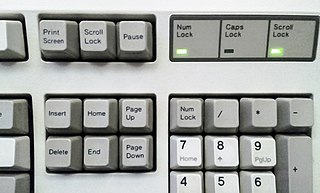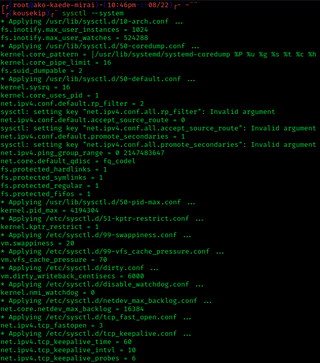The Break key of a computer keyboard refers to breaking a telegraph circuit and originated with 19th century practice. In modern usage, the key has no well-defined purpose, but while this is the case, it can be used by software for miscellaneous tasks, such as to switch between multiple login sessions, to terminate a program, or to interrupt a modem connection.
The keyboard for IBM PC-compatible computers is standardized. However, during the more than 30 years of PC architecture being frequently updated, many keyboard layout variations have been developed.

Scroll Lock is a lock key on most IBM-compatible computer keyboards.
System Request is a key on personal computer keyboards that has no standard use. Introduced by IBM with the PC/AT, it was intended to be available as a special key to directly invoke low-level operating system functions with no possibility of conflicting with any existing software. A special BIOS routine – software interrupt 0x15, subfunction 0x85 – was added to signal the OS when SysRq was pushed or released. Unlike most keys, when it is pressed nothing is stored in the keyboard buffer.
AmigaDOS is the disk operating system of the AmigaOS, which includes file systems, file and directory manipulation, the command-line interface, and file redirection.
In computing, a loadable kernel module (LKM) is an object file that contains code to extend the running kernel, or so-called base kernel, of an operating system. LKMs are typically used to add support for new hardware and/or filesystems, or for adding system calls. When the functionality provided by an LKM is no longer required, it can be unloaded in order to free memory and other resources.
A secure attention key (SAK) or secure attention sequence (SAS) is a special key or key combination to be pressed on a computer keyboard before a login screen which must, to the user, be completely trustworthy. The operating system kernel, which interacts directly with the hardware, is able to detect whether the secure attention key has been pressed. When this event is detected, the kernel starts the trusted login processing.
9P is a network protocol developed for the Plan 9 from Bell Labs distributed operating system as the means of connecting the components of a Plan 9 system. Files are key objects in Plan 9. They represent windows, network connections, processes, and almost anything else available in the operating system.

In computing, the menu key or application key is a key previously found on Microsoft Windows-oriented computer keyboards. It was introduced at the same time as the Windows logo key. On keyboards including the key, its symbol would usually be a small icon depicting a pointer hovering above a menu; it would typically be found on the right side of the keyboard between the right Windows logo key and the right control key. While the Windows key is present on the vast majority of keyboards intended for use with the Windows operating system, the menu key was frequently omitted in the interest of space, particularly on portable and laptop keyboards.
The proc filesystem (procfs) is a special filesystem in Unix-like operating systems that presents information about processes and other system information in a hierarchical file-like structure, providing a more convenient and standardized method for dynamically accessing process data held in the kernel than traditional tracing methods or direct access to kernel memory. Typically, it is mapped to a mount point named /proc at boot time. The proc file system acts as an interface to internal data structures about running processes in the kernel. In Linux, it can also be used to obtain information about the kernel and to change certain kernel parameters at runtime (sysctl).
sysfs is a pseudo file system provided by the Linux kernel that exports information about various kernel subsystems, hardware devices, and associated device drivers from the kernel's device model to user space through virtual files. In addition to providing information about various devices and kernel subsystems, exported virtual files are also used for their configuration.

sysctl is a software utility of some Unix-like operating systems that reads and modifies the attributes of the system kernel such as its version number, maximum limits, and security settings. It is available both as a system call for compiled programs, and an administrator command for interactive use and scripting. Linux additionally exposes sysctl as a virtual file system.
In computing, a keyboard shortcut is a sequence or combination of keystrokes on a computer keyboard which invokes commands in software.
The TCP window scale option is an option to increase the receive window size allowed in Transmission Control Protocol above its former maximum value of 65,535 bytes. This TCP option, along with several others, is defined in RFC 7323 which deals with long fat networks (LFNs).
debugfs is a special file system available in the Linux kernel since version 2.6.10-rc3. It was written by Greg Kroah-Hartman.
dm-crypt is a transparent block device encryption subsystem in Linux kernel versions 2.6 and later and in DragonFly BSD. It is part of the device mapper (dm) infrastructure, and uses cryptographic routines from the kernel's Crypto API. Unlike its predecessor cryptoloop, dm-crypt was designed to support advanced modes of operation, such as XTS, LRW and ESSIV, in order to avoid watermarking attacks. In addition to that, dm-crypt addresses some reliability problems of cryptoloop.

The Linux console is a system console internal to the Linux kernel. A system console is the device which receives all kernel messages and warnings and which allows logins in single user mode. The Linux console provides a way for the kernel and other processes to send text output to the user, and to receive text input from the user. The user typically enters text with a computer keyboard and reads the output text on a computer monitor. The Linux kernel supports virtual consoles – consoles that are logically separate, but which access the same physical keyboard and display. The Linux console are implemented by the VT subsystem of the Linux kernel, and do not rely on any user space software. This is in contrast to a terminal emulator, which is a user space process that emulates a terminal, and is typically used in a graphical display environment.
printk is a C function from the Linux kernel interface that prints messages to the kernel log. It accepts a string parameter called the format string, which specifies a method for rendering an arbitrary number of varied data type parameter(s) into a string. The string is then printed to the kernel log.
Control-Alt-Delete is a computer keyboard command on IBM PC compatible computers, invoked by pressing the Delete key while holding the Control and Alt keys: Ctrl+Alt+Delete. The function of the key combination differs depending on the context but it generally interrupts or facilitates interrupting a function. For instance, in pre-boot environment or in MS-DOS, Windows 3.0 and earlier versions of Windows or OS/2, the key combination reboots the computer. Starting with Windows 95, the key combination invokes a task manager or security related component that facilitates ending a Windows session or killing a frozen application.

vnStat is a network utility for the Linux operating system. It uses a command line interface. vnStat command is a console-based network traffic monitor. It keeps a log of hourly, daily and monthly network traffic for the selected interface(s) but is not a packet sniffer. The traffic information is analyzed from the proc filesystem. That way vnStat can be used even without root permissions.





